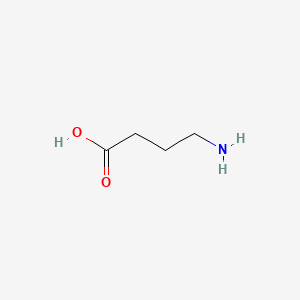4-aminobutyric acid
4-aminobutyric acid is a lipid of Fatty Acyls (FA) class. 4-aminobutyric acid is associated with abnormalities such as Epilepsy and Premenstrual syndrome. The involved functions are known as Binding (Molecular Function), neuron survival, Process, Uptake and physiological aspects. 4-aminobutyric acid often locates in Microglial, Neurofilament, Neuraxis, Brain region and Neurites. The associated genes with 4-aminobutyric acid are arginine methyl ester, SLC33A1 gene, NKS1 gene, P4HTM gene and ITSN2 gene. The related lipids are pregnenolone sulfate, pregnane-20-one, Pregnanes, Steroids and endogenous steroids.
Cross Reference
Introduction
To understand associated biological information of 4-aminobutyric acid, we collected biological information of abnormalities, associated pathways, cellular/molecular locations, biological functions, related genes/proteins, lipids and common seen animal/experimental models with organized paragraphs from literatures.
What diseases are associated with 4-aminobutyric acid?
4-aminobutyric acid is suspected in Premenstrual syndrome, Epilepsy and other diseases in descending order of the highest number of associated sentences.
Related references are mostly published in these journals:
| Disease | Cross reference | Weighted score | Related literature |
|---|
Possible diseases from mapped MeSH terms on references
We collected disease MeSH terms mapped to the references associated with 4-aminobutyric acid
PubChem Associated disorders and diseases
What pathways are associated with 4-aminobutyric acid
There are no associated biomedical information in the current reference collection.
PubChem Biomolecular Interactions and Pathways
Link to PubChem Biomolecular Interactions and PathwaysWhat cellular locations are associated with 4-aminobutyric acid?
Visualization in cellular structure
Associated locations are in red color. Not associated locations are in black.
Related references are published most in these journals:
| Location | Cross reference | Weighted score | Related literatures |
|---|
What functions are associated with 4-aminobutyric acid?
Related references are published most in these journals:
| Function | Cross reference | Weighted score | Related literatures |
|---|
What lipids are associated with 4-aminobutyric acid?
Related references are published most in these journals:
| Lipid concept | Cross reference | Weighted score | Related literatures |
|---|
What genes are associated with 4-aminobutyric acid?
Related references are published most in these journals:
| Gene | Cross reference | Weighted score | Related literatures |
|---|
What common seen animal models are associated with 4-aminobutyric acid?
There are no associated biomedical information in the current reference collection.
NCBI Entrez Crosslinks
All references with 4-aminobutyric acid
Download all related citations| Authors | Title | Published | Journal | PubMed Link |
|---|---|---|---|---|
| Torrealba F and Müller C | Ultrastructure of glutamate and GABA immunoreactive axon terminals of the rat nucleus tractus solitarius, with a note on infralimbic cortex afferents. | 1999 | Brain Res. | pmid:10023027 |
| Reiriz J et al. | Bone morphogenetic protein-2 promotes dissociated effects on the number and differentiation of cultured ventral mesencephalic dopaminergic neurons. | 1999 | J. Neurobiol. | pmid:10022564 |
| Nelson R et al. | Distribution of GABA(C)-like responses among acutely dissociated rat retinal neurons. | 1999 Jan-Feb | Vis. Neurosci. | pmid:10022489 |
| Napper GA et al. | Reduced glutamate uptake by retinal glial cells under ischemic/hypoxic conditions. | 1999 Jan-Feb | Vis. Neurosci. | pmid:10022486 |
| Osborne NN | Memantine reduces alterations to the mammalian retina, in situ, induced by ischemia. | 1999 Jan-Feb | Vis. Neurosci. | pmid:10022477 |
| Pérez-Cerdá F et al. | Postnatal development of perisomatic GABAergic axon terminals on neurons projecting from area 17 to area 18 of the cat visual cortex. | 1999 Jan-Feb | Vis. Neurosci. | pmid:10022476 |
| Pitkänen A et al. | Effects of vigabatrin treatment on status epilepticus-induced neuronal damage and mossy fiber sprouting in the rat hippocampus. | 1999 | Epilepsy Res. | pmid:10022367 |
| Albuquerque EX et al. | Neuronal nicotinic receptors modulate synaptic function in the hippocampus and are sensitive to blockade by the convulsant strychnine and by the anti-Parkinson drug amantadine. | 1998 | Toxicol. Lett. | pmid:10022256 |
| Kushnir MM et al. | Analysis of gabapentin in serum and plasma by solid-phase extraction and gas chromatography-mass spectrometry for therapeutic drug monitoring. | 1999 Jan-Feb | J Anal Toxicol | pmid:10022201 |
| Tobet SA et al. | Special relationship of gamma-aminobutyric acid to the ventromedial nucleus of the hypothalamus during embryonic development. | 1999 | J. Comp. Neurol. | pmid:10022198 |
| Guirado S et al. | Nucleus accumbens in the lizard Psammodromus algirus: chemoarchitecture and cortical afferent connections. | 1999 | J. Comp. Neurol. | pmid:10022193 |
| Wenk M et al. | Partial separation of synaptosomes accumulating 4-aminobutyrate or glutamate by zonal centrifugation on a discontinuous sucrose gradient. | 1976 | Hoppe-Seyler's Z. Physiol. Chem. | pmid:1002126 |
| Fisher SK and Davies WE | 4-Aminobutyric acid in the mammalian cochlear nucleus. | 1976 | Biochem. Soc. Trans. | pmid:1001676 |
| Mitchell JF | Release of physiologically active amino acids from intact brain and spinal-cord preparations. | 1976 | Biochem. Soc. Trans. | pmid:1001605 |
| Kovalev GV et al. | [Analysis of the ganglionic action of gamma-aminobutyric acid and its derivatives]. | 1976 Jul-Aug | Fiziol Zh | pmid:1001539 |
| Maitre M et al. | In vitro studies into the effect of inhibition of rat brain succinic semialdehyde dehydrogenase on GABA synthesis and degradation. | 1976 | FEBS Lett. | pmid:1001470 |
| Curtis DR et al. | Central actions of benzodiazepines. | 1976 | Brain Res. | pmid:1000299 |
| pmid: |
